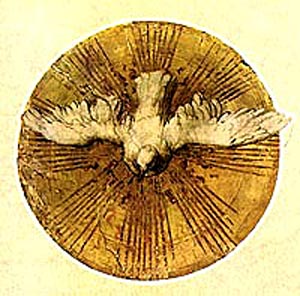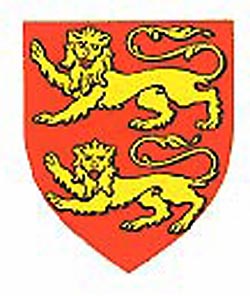 |
Symbolism
Vice and Virtue
Symbolized in the Animal Kingdom
Marian T. Horvat, Ph.D.
I am not an enthusiast of Greenpeace or the “eco-spirituality” movements that are becoming popular today. The “ecospiritualists” explain that every part of creation is a reflection of the divine, and they strive to re-establish the harmony between all living things.
However, it is clear that some of these New Age liberal movements are adopting a very basic error of the ancients. The ancient pagans considered Fall, Spring, Glory, Fecundity, etc. as persons symbolized by things. They erred in believing that the essence of the person symbolized was actually immanent in the symbol. Thus came the tendency toward having many gods. This is wrong.

The dove is a symbol of the Holy Ghost |
In Christian thinking, all of creation is understood to reflect the Creator, the one true God, and not through immanence by through the contemplation of God’s transcendence. From this sound and Catholic way of thinking, which developed in the Middle Ages, animals, flowers, the elements, and everything in Creation can symbolize some aspect of God and bring us to a closer understanding of the Creator.
Illustrated beastiaries (books about animals) were among the most popular and widely read books of the 12th and 13th centuries. Ours is not the first age that has been fascinated by animals, although ours is the first to provide restaurants and health spas for dogs and cats, and psycho-therapy for owners to deal with grief over the loss of pets. Medieval man had an entirely different, and much healthier, conception of the animal world, which existed for them primarily to reflect the order and beauty of God.
For example, Physiologus, a popular 12th century bestiary, tells us: “The turtle-dove loves her mate very much and lives chastely and faithfully with him, such that, if the male happens to be captured by a hawk or a fowler, she does not take another mate, but rather longs for and awaits her lost one at every moment and endures thus in remembrance and longing for him until death.”
Then follows the moral explanation for the dove’s behavior: “Take note, therefore, all you souls of the faithful, how much chastity is found in a small bird. All you who hear the person of the turtle-dove in the visage of the soul, imitate her chastity. For such is the Holy Church which, after seeing her mate crucified and resurrected on the third day and ascended into heaven, does not take another mate but longs for him and awaits him enduring in love and charity until death.”
 The lion represents royalty, vigilance, and militancy. William of Normandy placed two rampart lions on his coat of arms The lion represents royalty, vigilance, and militancy. William of Normandy placed two rampart lions on his coat of arms |
Likewise, the animal kingdom represented virtues for man to imitate. The dog was praised for its loyalty to its master, man, and this was expressed by the representation of dogs at the feet of tomb effigies, as seen in the picture. Even today, the Latin word Fido means trust. The lion, which was believed to sleep with his eyes open, became the symbol of Catholic vigilance and militancy. It was also thought that the lion had a strange myopia that permitted him only to see grand prey in the distance, and not the small creatures like mice and rabbits underfoot. Thus he became the symbol of the man of great horizons who was willing to undertake grand ventures for the love of God.
There are also legitimate explanations for the animals that are not so superior, which represent the vices that man must avoid. Physiologus explains that the water frog, which could not endure the rays of the sun for long periods of time, was like those men who could not stand abstinence. The owl is a creature of the night, which loves the darkness more than light, and gradually came to be associated with the occult sciences and freemasonry. The monkey represented the person of the devil since, in addition to lacking beauty, “he has a beginning but no end (that is, a tail).” The pig, which is created in away that his eyes always point to the ground, became a symbol of the man who always focused on the things of the earth.
In the 16th century, St. Francis de Sales, a Doctor of the Church who preached relentlessly against the Protestant heresy, also followed medieval tradition and turned to nature to better love and understand God. In his books and sermons there are constant references to animals and nature. The hawk that is hooded except when he takes flight should remind the man who loves chastity to practice custody of the eyes. We should not imitate the spider, he tells us, who represents the proud because he spins his web where everyone can see it, but the bee, who is the symbol of the humble soul, because it prepares its honey in the hive where his work is unseen.
As a teacher, I have always liked to introduce students to the animal kingdom in this way. A favorite assignment was to ask each student to choose an animal and write an short essay describing how its characteristics reflected the virtues or vices. Sometimes the paper was assigned after a trip to a zoo. The results were always overwhelming, as the eyes of the innocent opened to a wise way of observing the wonders of the universe.
With the overestimation of scientific information and factual knowledge, man has gained a more complete knowledge of the functional aspects of the created universe. Public television documentaries give detailed descriptions of how animals live, breed, and act in nature. But stirred by a naturalist tendency and an ignorance of the supernatural, we have amassed great hordes of information and lost sight of the ultimate meaning of the created universe.
It is Wisdom Himself who tells us that we may come to know and love God better by observing creation and seeking God in it: “For by the greatness of the beauty, and of the creature, the Creator of them may be seen, so as to be known thereby.”
|

Symbolism | Religious | Home | Books | CDs | Search | Contact Us | Donate

© 2002-
Tradition in Action, Inc. All Rights Reserved
|
 |
|
